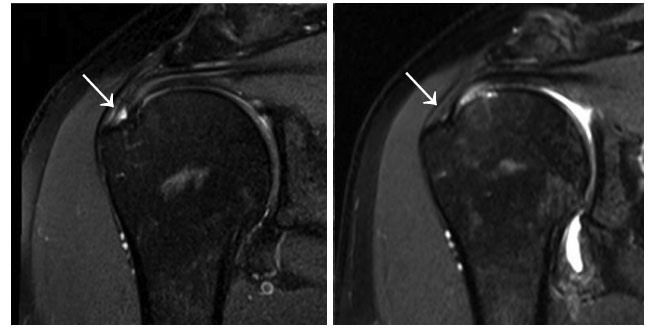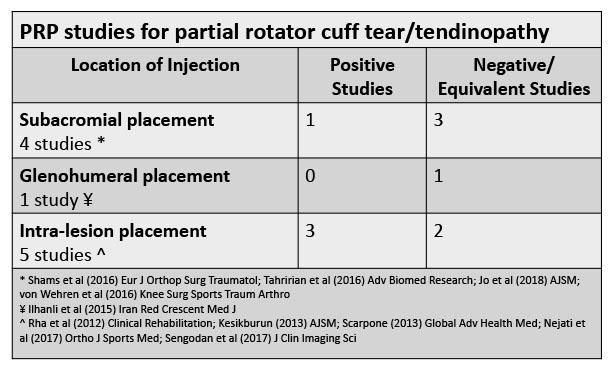
Alternatives to Rotator Cuff Surgery
Last week one of my patients came back with a new shoulder injury. He was previously seen a year ago and had a platelet rich plasma injection, or PRP injection, for a partial rotator cuff tear. He pain resolved after the PRP injection and he returned to the gym.
We don’t usually get a MRI after a biologic injection, but in this case we got a new MRI assess his recent injury and the rotator cuff tear we treated last year had resolved on the new MRI.

The MRI on the left shows the rotator cuff tear before the PRP (arrow). The tear is the white gap in the black/gray tendon. The MR arthogram on the right shows this tear has filled in. There is also white signal in the joint, which allowed us to see the patients new labral tear.
Partial thickness rotator cuff tears are common. Despite how common partial thickness tears are the majority of studies have focused on full thickness tears. Partial thickness tears have been relatively ignored and the treatment remains controversial (Matthewson et al 2015).
How do you get a partial rotator cuff tear?
The rotator cuff tendons are a group of 4 tendons (supraspinatus, infraspinatus, subscapularis, teres minor ) around the shoulder joint, and can be injured by repetitive activity or trauma (ie from a single event such as a fall).
Overhead activity increases stress on the most vulnerable tendon, by pinching the supraspinatus and shoulder bursa between the shoulder (humeral head) and shoulder blade (acromion). Initially, the injury may be diagnosed as a shoulder impingement, shoulder bursitis or rotator cuff tendinopathy (tendonitis).
In repetitive injuries, the pathology can progress over time. With continued stress on the tendon can develop a partial tear, and overtime small tears can increase in size.
What does a partial rotator cuff tear feel like?
Symptoms of a partial rotator cuff tear can vary. Some partial rotator cuff tears may go unnoticed because they don't always cause pain or are asymptomatic. In a study of asymptomatic individuals by Sher et al., the prevalence of rotator cuff tears on MRI was 20%. That means 1 out of 5 individuals are going about their normal lives with a partial rotator cuff tear.
In other patients, the partial tear can cause pain over the outside of the shoulder. Often patients will have pain with overhead activities, with a painful arc of motion between 60° and 120° of shoulder abduction or flexion.
How are partial rotator cuff tears diagnosed? Can a MRI miss a rotator cuff tear?
MRI are often used to diagnose rotator cuff tears. A MRI is a good test for a full thickness tear, where all of the fibers of the rotator cuff are torn.
However, for partial tears a MRI only has a sensitivity of 51.6%. This means that almost half of all partial tears are missed on a MRI. In many cases, partial tears will be described as high-grade tendinopathy. Ultrasound has been shown to have a similar efficacy to MRI in detecting partial rotator cuff tears, but accuracy is dependant on the skill of the physician performing the ultrasound scan.
Will a partial rotator cuff tear heal without surgery? Can a partial rotator cuff tear become a full tear?
Conservative treatment is effective in 73–80% of patients (Edwards, 2016). Physical therapy can help compensate for a damaged tendon, and the pain can resolve even if the tear does not close. However, not all patients respond to conservative management.
Over time, partial tears can progress to full thickness tears. There is some debate about how fast a partial tear can progress, but the larger the tear the more likely it is to progress. In one study, 28% of partial tears progressed to full thickness tears over a 12-month period (Yamanaka & Matsumoto, 1994).
Is surgery needed for partial rotator cuff tear?
Surgery should always be your last option. The characteristic of the tear, as well as, the patient symptoms serves as a guideline for treatment. Acute tears or chronic full-thickness tears greater than 1-1.5 cm are though to benefit from surgery.
Can platelet rich plasma (PRP) help me avoid surgery?
For some patients PRP can help them avoid surgery, even with larger partial tears. PRP works by stimulating the body to bring in new tendon cells and collagen to repair a tear. In the 10 studies looking at PRP for rotator cuff tears, the majority of studies where PRP was injected into the tear showed a benefit from the PRP.
However, not all PRP procedures are the same. The quality of the PRP and injection technique can impact the chances of success. In the studies looking at PRP for rotator cuff tears, in over half of the studies the authors intentionally did not inject the PRP into the tear. These studies injected the PRP either into the shoulder joint or the bursa space. In only 1 of these studies, the authors showed benefit, which shows how important it is to make sure the PRP is injected into the tear.

How do I decide if I am a candidate for PRP?
If you have only had a surgical consultation you may not know all your options. Partial rotator cuff tears may heal with non-operative management, including platelet rich plasma or PRP injections. A review of your MRI and a diagnostic ultrasound can help determine if a partial tear will respond to PRP.
Recommendations
Reference:
Brockmeyer M, Schmitt C, Haupert A, et al. Limited diagnostic accuracy of magnetic resonance imaging and clinical tests for detecting partial-thickness tears of the rotator cuff. Arch Orthop Trauma Surg. 2017 Dec;137(12):1719-1724.
Edwards P. Exercise rehabilitation in the non-operative management of rotator cuff tears: a review of the literature. Int J Sports Phys Ther. 2016 Apr; 11(2): 279–301.
Fukuda H. The management of partial-thickness tears of the rotator cuff. The Journal of Bone and Joint Surgery—British Volume. 2003;85(1):3–11.
Matthewson G, Beach CJ, Nelson AA, et al. Partial Thickness Rotator Cuff Tears: Current Concepts. Adv Orthop. 2015 (Epub).
Sher JS, Uribe JW, Posada A, et al. Abnormal findings on magnetic resonance images of asymptomatic shoulders. The Journal of Bone and Joint Surgery—American Volume. 1995;77(1):10–15.
Yamanaka K., Matsumoto T. The joint side tear of the rotator cuff: a followup study by arthrography. Clinical Orthopaedics and Related Research. 1994;(304):68–73.
Yamanaka K., Fukuda H. Pathological studies of the supraspinatus tendon with reference to incomplete thickness tear. In: Takagishi N., editor. The Shoulder. Tokyo, Japan: Professional Postgraduate Services; 1987. pp. 220–224.
Adductor longus selective tenotomy is a modern surgical treatment for chronic groin pain that offers faster recovery and better outcomes than traditional full release surgery. The adductor longus, an inner thigh
Read MoreDiscover how ultrasound helps diagnose plantar fat pad atrophy, a leading cause of ball-of-foot pain. Learn about symptoms, thickness cutoffs, and why early detection matters for relief.
Read More